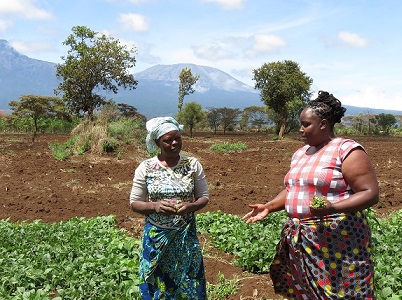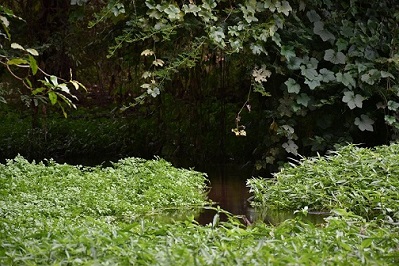For the better part of the year, parts of the Loitoktok earth in Kenya’s Kajiado County are hot and parched. But when it rains, it pours – with raging floodwaters tearing down trees and sweeping away tonnes of soil from a grassland bereft of tree cover save for the odd acacia tree.
Loitoktok lies in the dusty plains of Kilimanjaro on the Kenyan border with Tanzania; where huge gullies rip across a landscape that has endured extremes for generations.
Traditionally home to pastoralists from the Maasai community, Loitoktok has in recent years become a cosmopolitan urban area whose surrounding villages such as Entarara attract arable farmers from all over Kenya. They grow mainly tomatoes, onions, French beans and water melons under irrigation to boost their livelihoods.

Abigael Sein, left, harvesting French beans with one of her farm workers. Mt Kilimanjaro in the backdrop
Kajiado being a water deficit area, the rivers are seasonal. When they dry up, there is hardly water for livestock or domestic use. Except in the springs of Entarara Forest, a catchment for rivers Namunyelele and Olepolos.
A dense forest with lush undergrowth, its gigantic trees tower into the sky, standing guard over ancient and permanent springs. The forest not only hosts diverse species of flora and fauna, but its canopy creates a surprisingly cool and soothing micro-climate in an otherwise hot area.
“These springs never dried up. I remember as a young girl, we would trek four kilometres, seven times daily to fetch water from this forest when all water sources in my village were dry,” Abigael Sein, Treasurer of Entarara Onsoit Water Resources Users Association (WRUA) recalls.
Folding Trees into Wallets
But that was before loggers slunk into the forest and started nibbling away with power saws. Ageless trees were hewn down into timber for sale as other encroachers hoed and fenced inch by inch into the forest.

Abigael Sein, left, with Margaret Ngina and Agnes Saiyoki, the community scouts for Entarara Forest’s in awe of the rare Mnyanza tree
“They were folding trees and putting them in their wallets. There was no one to protect the forest because it is not owned by the government,” Margaret Ngina, who is today one of three caretakers employed by the Kajiado County Government to protect the forest.
Livestock owners seeking water and pasture drove their cattle into the forest, too, while farmers neighbouring the forest brought pumps and sunk pipes into the springs for irrigation. Not surprisingly, mother nature recoiled and the unthinkable happened. The springs dried up.
Degraded catchments and water points not only compromise supply and hygiene, but also impact most on rural women in Africa as they are often the major water users – as mothers, caregivers, farmers and custodians of livestock.
“Lack of water is life-threatening, and not just from thirst. When I was expecting my second child in 1997, I went to fetch water at Olepolos River for domestic use. My firstborn was on my back as was a 20-litre water container and some clothes I had washed. While trudging back home in darkness, I slipped and fell. Back then, there were no shallow wells. When the springs dried up years later, we were forced to sink shallow wells to survive the dry seasons. Mine is 60 feet deep,” says Abigael.
Community at Centre Stage
Alarmed at the turn of events, the officials of local WRUAs including Entarara Onsoit trained under the Watershed Project – a consortium of NGOs including Wetlands International in collaboration with national government water institutions, county governments, civil society organisations – petitioned the Kajiado County Government to protect the forest. The land was surveyed and demarcated at 43 acres. Human activities and grazing in the forest were banned in December 2017.

Agnes Saiyoki at the restored springs in Entarara Forest
Three community scouts, two of them women, were employed to protect the forest. And a reafforestation programme that has also been supported by the national government was launched with a focus on drought resilient trees.
“We know that this forest brings immeasurable blessings. It took only three years after halting human interference for the springs to come back. Presently, we can only use water from shallow wells for irrigation and livestock, and water from the Entarara Water Project for domestic use,” says Abigael.
Today, this ancient oasis is back, her water springs alive, rich and flowing to quench the thirst of thousands of upstream and downstream populations and their livestock. The endangered, towering Gigasiphon macrosiphon tree, locally known as Mnyanza, proudly stands guard; as does a community that almost lost this life-giving gem and biodiversity haven to encroachment and loggers. It has taken grit, wit and measured steps to restore it.
Article by Edward Indakwa and Elizabeth Wamba
